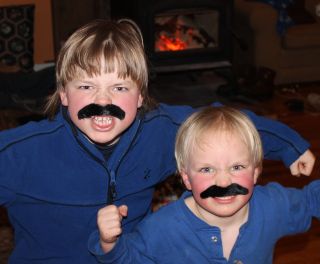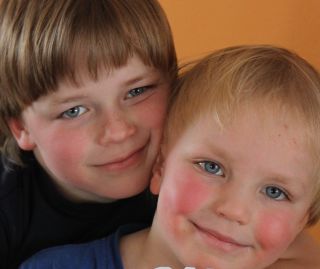Family Dynamics
Sibling Intensity and the Prospects for Peace
What hope do we have for the world if siblings cannot get along?!
Posted April 24, 2014
When our oldest two children were young, I had high hopes for world peace. Whenever a conflict between them erupted, I was always able to work it out by applying a few easy principles. Move with. Say sorry. Move on.
I would sit down with the two of them and listen to each side of the story. I would invite them to share their hurt feelings, and then name the hurt feelings of their sibling—to move with one another. I would help each of them identify the desire at the core of those feelings. I would encourage them to say sorry to one another, and then to let it go.
Nearly every time, as soon as those hurts were heard and touched and released, the kids moved quickly on, slipping back into this place of magical play that only they could enter. They met each other at the same level with the same language—the singsong hum of their voices a balm to my soul. By the time my third child was four, she too slipped right into that place of sibling play where the three nourish each other in ways that I cannot.
My experiences with these three supported the intuition I had in becoming a parent: I wanted to avoid an up-down family orientation and cultivate a round-about one instead. In an up-down orientation, the primary lanes of communication, cooperation, and compassion flow between parents and children. Children need; parents provide. In a round-about orientation, all members of the family help one other. Each individual nurtures a relationship with every other, to form a supporting mesh of enabling relations. It is a family mantra I have often repeated to each of them: You exist to help one another get what you each most want. It's our only hope for world peace. We are all brothers and sisters.
Experience with our youngest two sons, however, torpedoed my optimism. The relationship between these two is fierce. Passionate. Two brothers. Four years apart. When they are not screaming at one another, they are screaming because they cannot be with one another. When they are not wrestling in anger, they are wrestling with deep, infectious laughter that I rarely hear any other time. It is uncommon for a half hour to go by without jagged emotions erupting. Strategies for peacemaking honed on the older three are little help.
But I don’t like screaming! It is not what I want in my house. So I have kept reaching—beyond what I wrote in

Family Planting—to figure out how to help these two surf the intensity of their impulse to connect with one another—how to help them live it as love. In the process, I have discovered anew what it was about my experience with the earlier children that proved effective in the first place.
As I see it, the challenge of peacemaking among siblings—and if not there, then where—is not about learning to share. It lies in learning to manage the depths of sensation that the relationship yields. That pleasure forges a bond—prior to a full-fledged sense of ego or “I.” The bond creates attachment. Each child grows dependent upon the others for an emerging sense that “I am” and “I am OK”; that I am getting what I want—not just getting some particular object or opportunity, but getting everything that is and will be needed and wanted.
The challenge, then, is for siblings to learn how to greet the huge feelings they have in relation to one other as resources—as proof that they need each other in order to become who they have the potential to be. The feelings are proof that they will get what they want by helping their siblings do the same.
Nice idea, but how does it work?
First, some typical examples of sibling interaction.
Scene 1. Kai is intently building a building with blocks. He is passionate about it. Leif comes up beside him and tries to add a block to the tower. Kai cries: “No! Don’t touch it. You are going to wreck it!” Leif’s face contorts. In a flash, he knocks over the block tower. Both boys are screaming.
Scene 2. I ask Leif to get the cheese from the refrigerator. He hops out of his chair, eager to help. Kai jumps up, beats him to the refrigerator, opens it, snags the cheese, and puts it on the table in front of me, smiling. Leif howls in frustration, runs to the couch and buries his head in the pillows. I go to hug him and he pushes me away crying, “I don’t like myself!” Meanwhile Kai, upset that Leif is so upset, is yelling, “I was just doing what you wanted!”
Scene 3. The boys are playing on either side of a door, as I have asked them not to do many times before. Leif accidently pushes the door in a way that catches Kai’s toe. Kai howls in pain and starts yelling at Leif: “You meant to do that!” Leif yells back, infuriated: “I did not!” And they are screaming at one another while Kai pulls hard on his toe.
Scene 4: Kai complains all morning about how Leif always wants to play with the toy that Kai has just found. It is tiring. Leif finally falls asleep, taking an afternoon nap. Five minutes later Kai pouts: “I’m bored. I have nothing to do! I wish Leif would wake up! I want to play!”
Typical? Perhaps. Familiar? I am sure. In such cases—provided I can hold back from shouting even louder than they are in order to get them to be quiet—I am swamped with these huge emotions that the kids really need each other to help them relieve.
What to do? Dealing with a situation when emotions are crashing like giant waves is, well, difficult. Here are five guidelines we use to help these brothers not get boiled in the first place, and right themselves more quickly if they do.
1. One for you. One for me.
Your brother is always going to want what you want. You want to play with a toy? Get one for your brother. You want a bowl of cereal? Get one for your brother. You want to draw? Get a piece of paper for your brother. From the beginning.
2. Include, include, always include.
Your brother is always going to want to do what you are doing. Give him a way to participate. Welcome him over. Show him how he can help. He wants to participate. He wants to play. If you include him, he will not push your tower over.
3. Give and get.
Your brother is always going to want what you have. Give it to him—just for a moment. Get interested in something else—he will too. And then get back what you wanted at first, free to play. Spread the attention. You will get more. It works every time.
4. Make it a close race.
Your brother is always going to want to be as fast and helpful and smart and successful as you are. Competition is good, but it only works if it helps you grow. It will help you grow only when there is a chance you might lose. If one person wins too easily, the race isn’t fair. Make it fair. Give your brother a head start, the shorter sword, a heavier pack—then be prepared to lose! Show him how.
5. YOU WANT THE SAME THING.
You brothers want the same thing. You want to play. To be good. To help. To win. To have fun. You want the same thing. And the fact that you want the same thing is exactly what is going to help you have it! Help each other get it.
*
The kids don’t need to learn how to share. They have known since birth. Leif won’t even open a treat without knowing whether or not Kai can have one too.
Nor is it a matter of developing ‘impulse control’ in the prefrontal cortex. These kids are perfectly capable of composing themselves instantly when a teacher or stranger is present, or when their weekend movie privileges are in jeopardy.
I don’t buy the idea either that they will just ‘grow out of it’ without having formed some strong patterns of bodily movement, involving how to sense and respond to their own deepest desires. At this point in their lives, those movement patterns are fluid, still in the process of being created; they have not yet hardened into habits of fear or grief, defensiveness or judgment. These kids give and get, forgive and forget, easily. There is lots of play. Lots of laughter. Lots of creative possibility.
The question, rather, is how to help them move—how to help them find ways of moving in relation to one another that acknowledge and honor the depths at which they are moved by one another. The challenge is to remember the desires that bind—not as a source of conflict, but as a source motivating the acts of cooperation and compassion that enable them each to get what they want and need to continue—the fun. The love.
It is an ongoing experiment. I cling to hopeful signs.

Yesterday Kai was on the computer. I ask what he is doing. He says, “Shopping for binoculars.”
I say, “We already have a nice pair.”
“But Leif needs one. You know, one for you and one for me!” Kai replies.
I sigh. It is not the first time a push for peace has been coopted as a call for consumerism. I want to say that we don’t need another pair of binoculars, but I don’t. He's trying!
“Good thinking, Kai.”




